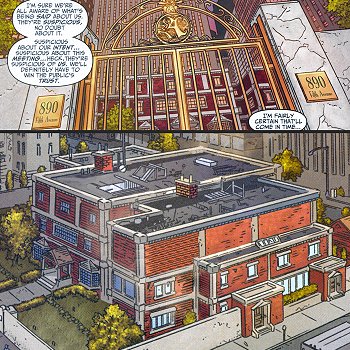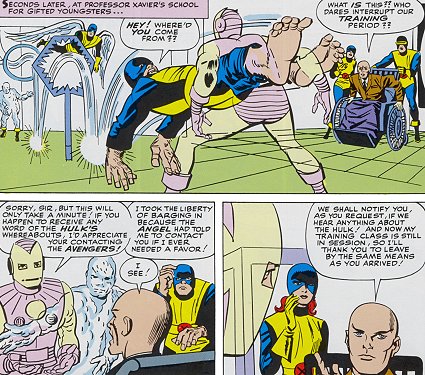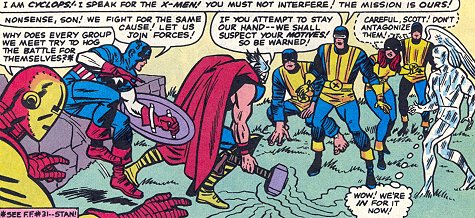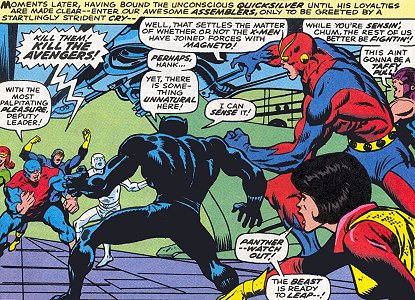Introduction
The X-Men. The Avengers. Two teams. Though unintentional, both teams represent polar opposites when it comes to the perceptions of the general public they are dedicated to serve. While the Avengers are not only celebrated as legitimate heroes and receive government sanction, accompanied by security clearance, the X-Men are “outlaw heroes,” who might be arrested immediately upon saving a city - or even the world. Likewise, the free press will eagerly cover an Avengers’ press conference where their new team line up is announced, however when the X-Men make the papers it is usually in an op-ed, describing the menace that they represent. The X-Men are sworn to defend a world that hates and fears them, while the Avengers are cheered on by a world that loves and adores them.
However, was the result of the difference in the public’s reception solely one dealing with racism, or even the fear of a new species supplanting humanity? It could be argued that the very way the two teams formed - and how they themselves interacted with the public they served to protect shaped the world’s views.
 For instance, when the Avengers were formed, the team was composed of individuals who already had established careers as costumed adventurers, their exploits known to the public and announced on newspaper headlines. Meanwhile, the X-Men were established first as a team, comprised of youths who were just beginning to understand their powers and how to use them and wholly unknown to the general public. Even the standard, bland, yellow and blue X-Men might have seemed disconcerting to the standard citizen, appearing as nameless, faceless automatons. While each Avenger had individual, colorful costumes, those of the X-Men were nearly monotone and foreboding.
For instance, when the Avengers were formed, the team was composed of individuals who already had established careers as costumed adventurers, their exploits known to the public and announced on newspaper headlines. Meanwhile, the X-Men were established first as a team, comprised of youths who were just beginning to understand their powers and how to use them and wholly unknown to the general public. Even the standard, bland, yellow and blue X-Men might have seemed disconcerting to the standard citizen, appearing as nameless, faceless automatons. While each Avenger had individual, colorful costumes, those of the X-Men were nearly monotone and foreboding.

For bases of operations, both teams made headquarters out of mansions. However, while the Avengers had theirs in downtown Manhattan, with a known address that city officials and even mail carriers could visit, the X-Men’s was secretly nestled in upstate New York, its address unknown and its residents sequestered from the world they served to protect.
Preceding both the arrival of the Avengers and X-Men were the Fantastic Four. Much like the X-Men, they possessed uniforms, rather than costumes. However, unlike the other two teams, their identities had been public from the beginning, and of course their headquarters well known and publicized. In this manner, the Fantastic Four were a middle ground of sorts in regards to their presentation to the public.
Whether the fault was their own or the public’s perception inevitable, the Avengers definitely gave the benefit of the doubt to the group of teens enigmatically calling themselves “the X-Men.” After all, in their first outing, they had saved a US military base from another, evil mutant. This trust, far beyond what the citizenry would ever bestow, served the two teams well over the years. However, certain decisions of the X-Men and their associations were hard to accept by the Avengers, occasionally causing friction, though never outright animosity. Despite these occasional setbacks, the two teams would always come together during times of crisis, sharing information whenever it was necessary.
This article will demonstrate how these two teams have interacted with each other over the years, and how that relationship has evolved. Like each other, the ranks of each team have changed from time to time, though the mission statement of each has always remained the same - to serve the world in their own way.
Early Encounters
The first meeting between the two teams was not a formal one, or even a full roster encounter. It was Iron Man, attempting to track down the Hulk on behalf of the Avengers. Shortly after the formation of their group, the Avengers lost their first member when the Hulk departed after realizing that his teammates did not trust him. Feeling that he was their responsibility, the Avengers decided to search for the green behemoth and Iron Man immediately suggested that they use “Tony Stark’s” latest invention, the Image Projector. Using the device, Iron Man projected his image around New York, asking other heroes for their assistance.
 A few weeks prior, Iron Man had met the Angel and found him to be an honorable hero. As such, among the other heroes of the New York area, Iron Man decided to contact the X-Men at Xavier’s school. Xavier agreed to contact the Avengers, should they hear anything of the Hulk’s location, though he then promptly asked the Golden Avenger to leave, as he was in the middle of class. In those early days, Xavier had been almost excessively stern to his students, acting like a drill instructor as he molded them into a fighting unit. While it is unclear if his annoyance at the Avenger was genuine, it was hardly the best of first encounters. Whether it is a coincidence or not, Iron Man seemed to have abandoned use of the Image Projector soon thereafter. [Avengers (1st series) #3]
A few weeks prior, Iron Man had met the Angel and found him to be an honorable hero. As such, among the other heroes of the New York area, Iron Man decided to contact the X-Men at Xavier’s school. Xavier agreed to contact the Avengers, should they hear anything of the Hulk’s location, though he then promptly asked the Golden Avenger to leave, as he was in the middle of class. In those early days, Xavier had been almost excessively stern to his students, acting like a drill instructor as he molded them into a fighting unit. While it is unclear if his annoyance at the Avenger was genuine, it was hardly the best of first encounters. Whether it is a coincidence or not, Iron Man seemed to have abandoned use of the Image Projector soon thereafter. [Avengers (1st series) #3]
It was not long afterward, however, that both teams met each other in full. Called by their mentor and founder, Professor X, the X-Men traveled to the Balkans, where Xavier had located an old foe who had resurfaced, the alien would-be despot known as Lucifer. Shortly after their arrival, the X-Men were met by the Avengers, who had followed strange, evil impulses detected by Thor’s mystical hammer, Mjolnir. Realizing that the impulses were leading them to Lucifer, Xavier instructed the X-Men to stop the Avengers, as he had just learned that Lucifer had attuned a thermal bomb to his heartbeat and any harm to him would obliterate Europe.
It is interesting that, when ordered by Cyclops that the Avengers must not interfere, rather than being distrustful, Captain America immediately volunteered that they join forces, clearly viewing the X-Men as a force for good. Thor, however, was wary,  as he cautioned the X-Men that their actions might cause the Avengers to suspect their motives. Neither side giving in, the situation quickly resulted in a battle, with the X-Men actually holding their own against the older and more experienced Avengers. Eventually, the battle was ended when Xavier telepathically contacted Thor and informed him of the situation with Lucifer. Believing his word, Thor called for the Avengers to depart, which they did, the trust the Avengers seemed to have had before the battle having been restored. Shortly thereafter, the X-Men defeated Lucifer, safely defusing the bomb in the process. [X-Men (1st series) #9]
as he cautioned the X-Men that their actions might cause the Avengers to suspect their motives. Neither side giving in, the situation quickly resulted in a battle, with the X-Men actually holding their own against the older and more experienced Avengers. Eventually, the battle was ended when Xavier telepathically contacted Thor and informed him of the situation with Lucifer. Believing his word, Thor called for the Avengers to depart, which they did, the trust the Avengers seemed to have had before the battle having been restored. Shortly thereafter, the X-Men defeated Lucifer, safely defusing the bomb in the process. [X-Men (1st series) #9]
A few weeks later, yet another confrontation between the X-Men and their greatest foe, Magneto, the self-styled “master of magnetism,” resulted in his abduction by an alien entity called the Stranger. Months after, however, Magneto found his way back to Earth from the Stranger’s world and immediately sought out Quicksilver and the Scarlet Witch, former members of his Brotherhood of Evil Mutants. During the intervening months, they had become Avengers themselves, showing that mutants (and former criminals for that matter) were not barred from their organization. However, through trickery, Magneto convinced Quicksilver that a bullet meant for Magneto by humans had been deliberately aimed at Wanda, when in fact the trigger had been pulled and the projectile’s course magnetically altered by Magneto himself. Magneto further blamed the loss of the Witch’s hex powers on the incident and took both Pietro and Wanda to his island fortress, where he planned to work on a device to restore them. [Avengers (1st series) #46, 48-49]
 Eventually, the X-Men discerned Magneto’s location and attacked, though they were defeated and imprisoned. Fortunately, the Angel managed to escape and enlisted the aid of the Avengers, who quickly made their way to the island. Just before disembarking, however, the Wasp discovered a listening device in the Angel’s wings, leading the group to conclude that he must be in league with Magneto. To further support this, when the Avengers entered the base, they were confronted by the rest of the X-Men, ready to kill the intruders on Magneto’s behalf.
Eventually, the X-Men discerned Magneto’s location and attacked, though they were defeated and imprisoned. Fortunately, the Angel managed to escape and enlisted the aid of the Avengers, who quickly made their way to the island. Just before disembarking, however, the Wasp discovered a listening device in the Angel’s wings, leading the group to conclude that he must be in league with Magneto. To further support this, when the Avengers entered the base, they were confronted by the rest of the X-Men, ready to kill the intruders on Magneto’s behalf.
However, the fight was short-lived, when the Avengers prevailed after the machinery Magneto had been using to control the X-Men mentally was deactivated by the Angel, who had not actually been tied up in the Quinjet, as Magneto believed. Knowing full well that the X-Men were heroes and would never team up with Magneto, the Avengers had immediately surmised that the Angel had been unaware of the listening device in his wings and instead used the fact that their shared enemy was listening to distract him. While the Avenger confronted the X-Men, the Angel had entered from another avenue and thwarted Magneto from his flank. Clearly, the Avengers trust with the X-Men was strong enough to give them far beyond the benefit of the doubt. Facing defeat, Magneto activated a self-destruct sequence, forcing to X-Men and Avengers to flee, while he supposedly perished. [X-Men (1st series) #43-45, Avengers (1st series) #53]
Much later, the Avengers would once again come to the aid of the X-Men, when they received a video message showing the mutants defeated in their mansion. They had been beaten by Magneto, but the Avengers didn’t know this when they entered the mansion and found the unconscious X-Men, among them Magneto himself, disguised as the Angel with a fake pair of wings. Magneto also overcame half of the Avengers, including the Scarlet Witch, with his rather new-found ability of controlling his victims’ blood flow to the brain, making them submissive to his orders. With his small army of super-powered individuals, Magneto then kidnapped the members of the Atomic Energy Commission, wanting to start a nuclear war, but eventually the remaining Avengers defeated him with the help of Daredevil and the Black Widow. [Avengers (1st series) #110-111]
